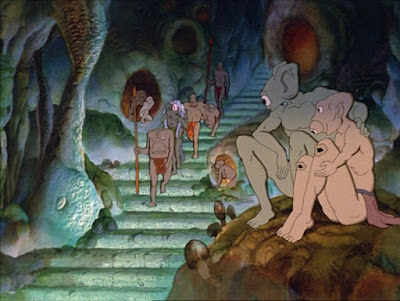(1987) Directed by René Laloux;
Written by René Laloux and Roland Topor; Based on the novel Les Hommes Machine
Contre Gandhar, by Jean-Pierre Andrevon; Starring: Pierre-Marie Escourrou, Catherine
Chevallier, Georges Wilson and Anny Duperey; Available on DVD (Region 2)
Rating: ****
“What do you know of time, of its continuity, its traps, its false perspectives, its apparent paradoxes, its relation to space?” – Métamorphe (Georges Wilson)
When animator René Laloux burst onto the scene with his pioneering
animated science fiction film Fantastic Planet (aka: La Planète Sauvage),
it should have been his ticket to creating more stunning works. Instead, his career
could best be described as fits and starts, as he created only two other full-length
movies, Les Maîtres du Temps (aka: Time Masters), and today’s film.
Gandahar (the American version, Light Years, featured a
screenplay by Isaac Asimov)* may not be a direct sequel to Fantastic Planet, but
could easily reside in the same universe. Much like his earlier film, Laloux has
populated his alien world with a diverse array of unusual creatures and odd
landscapes, accompanied by a fittingly mind-bending story.
* Fun Fact: For Gandahar’s animation, Laloux utilized S.E.K. (Scientific Educational Korea) studios, located in Pyongyang, North Korea. Over the years, S.E.K. has been involved with numerous international productions, including several high-profile American animated TV shows and films.
The film is set on the utopian world of Gandahar, where the residents live a peaceful existence, free of war or other ills of society. Civilization falls into disarray after the residents of Gandahar suffer an attack from an unknown source. Sylvain, an inexperienced young soldier, is sent to investigate the disturbance, and in the course of his journey, encounters a formidable robot army. Although he becomes a prisoner of the robots, he manages to escape with a fellow Gandaharian, Airelle. They fall in love, but duty calls, as Sylvain learns his true destiny – in order to save the present, he must travel 1,000 years into the future.
In Sylvain’s travels, he encounters a race of outcasts known
as the Deformed. According to their unique perception of time, woven into their
language (instead of saying something “is,” it’s “was will be”), they discuss
events in the past and future, rather than the present. When Sylvain asks their
leader for clarification (“Past in future, and future in past?”), he replies, “We
don’t understand it any better than you, but it has become our nature, and the
past-future has become our way of speaking and believing.” While their concept
of time may seem superficially alien, it’s relevant to many of us who fear living
in the present. We often lament what has passed and spend an inordinate amount
of thought, anticipating what may be. The Deformed, Sylvain’s presumed enemies,
become his ally in the fight against the robot invaders.
It’s not too much of a stretch to speculate that Laloux, who
grew up during the Nazi occupation of France in World War II, would likely
incorporate anti-fascist themes into his work. The totalitarian robot regime, with
its mindless battalions, pledge their unquestioning fealty to their leader, the
giant brain/demigod Métamorphe (“The Great Procreator”). They wage war against
the easy-going residents of Gandahar and their individuality, in favor of a society
based on subservience. In the future Gandahar, humans are
harnessed for their power and discarded into a heap after they’ve outlived their
usefulness – a sobering parallel to the real-life horrors of the concentration
camps.
Gandahar doesn’t fall into the trap of some science
fiction films, with lengthy passages of expository dialogue that stall the plot.
Instead, Laloux counts on the viewer to take in the sights and connect the
dots. The human residents of Gandahar once originated from Earth, and countless
ages later, still remember the stories and poems from that distant planet. They
established a better life, but there’s a trade-off for their idyllic society.
The Deformed were, in their words, “the victims of your research in the field
of genetics.” Similar to Frankenstein’s creation, they were shunned by their
creators and forced into exile. The film embraces the Frankenstein metaphor a
step further with Gandahar’s enemy Métamorphe, an artificial consciousness that
originated as a science experiment.
Compared to the more experimental look of Fantastic Planet (incorporating a distinctive cross-hatch art style, and employing a hybrid of cell animation with paper cutouts), Gandhar falls back on more conventional animation methods. There’s also some obvious cost cutting measures, with duplicated shots (depicting the robots marching). While Gandahar doesn’t break new ground, artistically, it more than compensates with its fanciful, immersive depictions of an alien world, and pastel-colored palette. Along with its eye-pleasing visuals, it presents a thought-provoking story that challenges viewers to reach their own conclusions. Unfortunately, it’s not particularly easy to come by the DVD of the French version (an excellent copy was released by Eureka in 2007), but it’s well worth seeking out.
Source for this article:
René Laloux, The Man Who Made 'La Planète Sauvage' ('The Fantastic
Planet'), by Philippe Moins, Animation World Network.








Great review, Barry!
ReplyDeleteI've enjoyed fantastic planet over the years, so I'm sure I would enjoy this one too.
Thanks so much, John! It has the same trippy vibe as Fantastic Planet, so I'm sure you'd dig this as well. Now, if they'd just release it on DVD in the States...
DeleteI am just learning about this film for the first time. It seems Avatar and the Matrix borrowed heavily from this. “The secret to genius is hiding your sources” AE
ReplyDeleteI wouldn't be surprised if this provided some inspiration for both films (and many others). Such a fascinating film.
Delete